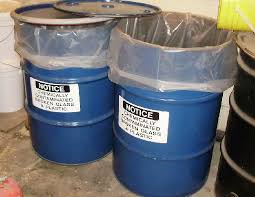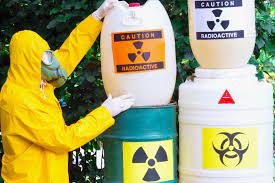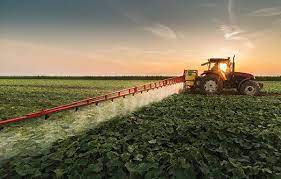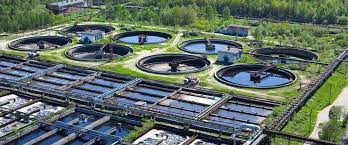Hazardous Substance Treatment and Disposal
The purpose of this unit is to describe the various options available for the treatment and disposal of hazardous substances/waste. In the preceding chapter, we defined hazardous substances as substances/materials whose nature or/and amount and/or concentration, either directly or indirectly, can pollute or damage the environment, and/or may endanger the environment, human health, and survival of human beings as well as other lives.
Substances are classified as hazardous when they display one or more of these characteristics: explosive, oxidizing, flammable, irritant, harmful, toxic, carcinogenic, as well as harmful effects on the environment and human health (Kummer, 1999).
These substances generate wastes which are dangerous or difficult to keep, treat, or dispose of without additional precautions. Some are non-degradable, while some are highly toxic and can be biologically magnified.
One of the first principles in waste management is to avoid waste generation in the first instance. But, since generation of hazardous and toxic wastes cannot be avoided because of their nature, proper care is expected to be followed in disposing the toxic wastes and hazardous substances. Disposal is the final stage of the hazardous waste management system.
Blackman (2001) noted that “Disposal of hazardous waste has been accomplished in every mode of behaviour – careful and careless, casual and furtive, clever and mindless, etc. The simple (take it out back and dump it) practice was commonplace.
As case histories of contaminated sites continue to be developed, the practice of dumping solvents and other liquid wastes into the ground, into ditches, (incredibly) into drainage wells, into seepage pits, and into trash dumps is often found to have been the mechanism or practice involved.”
In hazardous substance/waste management, wastes are separated into three broad groups: radioactive, chemical, and bio-hazardous.
Radioactive waste is classified as either low-level or high-level waste. Low-level waste is typically found in households, medical and research institutions, while high-level waste is typically generated by nuclear reactors.
Read Also : Pathways of Hazardous Substances
Chemical waste includes a wide range of materials, such as discarded commercial chemical products, process wastes, and wastewater.
Bio-hazardous waste is a term used to describe different types of waste that might include infectious agents.
Hazardous Substances/Waste Treatment Technologies
The issue of hazardous substance/waste treatment is complex. This is because the selection of treatment technologies requires a great deal of substance characterisation to determine the waste properties and depends on the availability, affordability and need for environmentally friendly technologies.
Although, there are rules and guidelines governing disposal of hazardous substances and wastes, these wastes still find their way to public landfills, nearby dumpsites, drainage channels or water ways, raising serious environmental concerns. In order to curtail these concerns, hazardous substances/wastes are first treated so as to reduce their toxic and hazardous nature prior to their ultimate or final disposal.
Treatment technologies refer to those techniques which decompose or break down the hazardous substances and their associated waste into non-hazardous constituents. Many waste treatment technologies can provide permanent, immediate, and very high degrees of hazard reduction.
The treatment technologies are divided into four main methods:
Biological methods: Composting, aerobic and anaerobic decomposition, activated sludge, enzyme treatment, etc.
Physical methods: Drying, screening, grinding, evaporation, sedimentation, filtration, fixation, etc.
Chemical Methods: Oxidation, reduction, neutralisation, hydrolysis, etc.
Thermal Methods: Incineration, boiling, autoclaving, ultraviolet treatment, microwave treatment etc.
Amongst the treatment methods, thermal method seems to be the preferred and most innovative disposal technique used in treatment and disposal of hazardous substances and wastes.
Incineration
Incineration is the preferred means of treatment and disposal for most organic and selected inorganic hazardous wastes. Incineration is simply the controlled combustion of waste materials in order to reduce them to a non-combustible residue or ash and exhaust gases, i.e., carbon dioxide and water.
It is mostly used to treat wastes that cannot be recycled, reused, or disposed of in a landfill site. There are many different types of incineration technology, but the Rotary Kiln, Multiple Hearth and Fluidized Bed Furnaces have been shown to be the most versatile for hazardous substances and waste management.

Basic methods of thermal incineration includes: combustion, pyrolysis, gasification, vitrification, detonation.
Boiling, autoclaving, ultraviolet treatment and microwave treatment are also used to treat hazardous substances, especially those from clinical and bio-hazardous wastes, while most chemical wastes are treated using chemical and physical methods.
Hazardous Waste Disposal
After treatment has been applied to reduce or remove the toxic and hazardous nature of the substance to man and his environment. The final waste has to be discarded and properly disposed in a safe and suitable location.
The disposal method is dependent on the nature of the waste as well as the geographical location of the waste generator or treatment plant or the specified disposal location.
Based on this, hazardous substances can be disposed through one of these mediums: Land, Water, and Air.
With land being the main disposal medium with significant impact on air and water we will concentrate on those disposals that take place on land.
Open Dumps: They are locations where illegally dumped, abandoned piles of garbage and debris are left in large quantities either on temporary or permanent basis. They have the lowest initial capital investment and operating cost and are generally sited in vacant plots of land.
Because they are not controlled, hazardous substances, especially household hazardous wastes, are often disposed in them which often present an increased risk to ground and surface water quality and health risks to surrounding residents.
Landfills: This is the burial of waste in excavated trenches or cells. The waste may be in bulk form or containerized. It has been established that, for most parts, hazardous wastes are treated in unlicensed facilities using conventional methods, such as landfilling (Mmereki, Baldwin, Hong and Li, 2016).
Two types of landfills are normally used for hazardous waste disposal, namely, controlled landfills and secured or sanitary landfills.
Controlled Landfills:These are non-engineered disposal sites at which wastes are deposited in accordance with minimum prescribed standards of site operation. Typically controlled landfills have minimal site infrastructure with improved operational and management procedures.
The site is generally identified on the basis of land availability and convenience and is already being used as an open dump. The site is not earmarked on the basis of technical, environmental or financial criteria.
Secured or Sanitary Landfills:A secure landfill is a carefully engineered depression in the ground (or built on top of the ground) consisting of a bottom liner, leachate collection system, cover, and natural hydrogeological setting. The aim is to avoid any hydraulic (water-related) connection between the wastes and the surrounding environment, particularly groundwater.
Deep-Well Injection:This disposal method uses injection wells to place treated or untreated liquid waste into geologic formations that have no potential to allow migration of contaminants into potential potable water aquifers.
This method involves pumping liquid waste through a steel casing into a porous layer of limestone or sandstone. High pressures are applied to force the liquid into the pores and fissures of the rock, where it is to be permanently stored.
This method is relatively inexpensive and requires little or no pre-treatment of the waste, but it poses a danger of leaking hazardous waste and eventually polluting subsurface water supplies.
Read Also : Water and Wastewater Management Complete Guide
Surface Impediment: This method involves arresting or demobilizing the movement or migration of the waste by containing it in a hard core: clay soil, thermoplastic polymers, non- corrosive metallic containers (carbon-steel tanks), cement, lime, fire glass, and/or rocks.
Ocean Dumping: This is a practice where hazardous substances and waste are disposed into water bodies. Despite the existing public protests and regulations against use of this method, waste generators and disposal firms have continued to dump hazardous and other forms of waste into water bodies.



